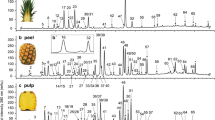Abstract
In this study, an ethanolic extract from Portuguese propolis was prepared, fractionated by high-performance liquid chromatography, and the identification of the phenolic compounds was done by electrospray mass spectrometry in the negative mode. This technical approach allowed the identification of 37 phenolic compounds, which included not only the typical phenolic acids and flavonoids found in propolis from temperate zones but also several compounds in which its occurrence have never been referred to in the literature. Four of the novel phenolic compounds were methylated and/or esterified or hydroxylated derivatives of common poplar flavonoids, although six peculiar derivatives of pinocembrin/pinobanksin, containing a phenylpropanoic acid derivative moiety in their structure, were also identified. Furthermore, the Portuguese propolis sample was shown to contain a p-coumaric ester derivative dimer.






Similar content being viewed by others
References
Wollenweber E, Hausen BM, Greenaway W (1990) Phenolic constituents and sensitizing properties of propolis, poplar balsam and balsam of Peru. Bulletin de Groupe Polyphenol 15:112–120
Marcucci MC (1995) Propolis: chemical composition, biological properties and therapeutic activity. Apidologie 26:83–99
Burdock GA (1998) Review of the biological properties and toxicity of bee propolis (propolis). Food Chem Toxicol 36:347–363
Banskota AH, Tezuka Y, Kadota SH (2001) Recent progress in pharmacological research of propolis. Phytother Res 15:561–571
Sforcin JM (2007) Propolis and the immune system: a review. J Ethnopharmacol 113:1–14
Gekker G, Hu S, Spivak M, Lokensgard JR, Peterson PK (2005) Anti-HIV-1 activity of propolis in CD4+ lymphocyte and microglial cell cultures. J Ethnopharmacol 102:158–163
Chen J, Long Y, Han M, Wang T, Chen Q, Wang R (2008) Water-soluble derivative of propolis mitigates scopolamine-induced learning and memory impairment in mice. Pharmacol Biochem Behav 90:441–446
Yildirim Z, Hacievliyagil S, Kutlu NO, Aydin NE, Kurkcuoglu M, Iraz M, Durma R (2004) Effect of water extract of Turkish propolis on tuberculosis infection in guinea-pigs. Pharmacol Res 49:287–292
Tosi EA, Ré E, Ortega ME, Cazzoli AF (2007) Food preservative based on propolis: bacteriostatic activity of propolis polyphenols and flavonoids upon Escherichia coli. Food Chem 104:1025–1029
Vardar-Ünlü G, Silici S, Ünlü M (2008) Composition and in vitro antimicrobial activity of Populus buds and poplar-type propolis. World J Microbiol Biotechnol 24:1011–1017
Bankova VS, De Castro SL, Marcucci MC (2000) Propolis: recent advances in chemistry and plant origin. Apidologie 31:3–15
Salatino A, Teixeira ÉW, Negri G, Message D (2005) Origin and chemical variation of Brazilian propolis. eCAM 2:33–38
König B (1985) Plant sources of propolis. Bee World 66:136–139
Marcucci MC, Bankova VS (1999) Chemical composition, plant origin and biological activity of Brazilian propolis. Curr Top Phytochem 2:115–123
Park YK, Alencar SM, Aguiar CL (2002) Botanical origin and chemical composition of Brazilian propolis. J Agric Food Chem 50:2502–2506
Cuesta-Rubio O, Frontana-Uribe BA, Ramırez-Apan T, Cardenas J (2002) Polyisoprenylated benzophenones in Cuban propolis; biological activity of nemorosone. Z Naturforsch, C 57:372–378
Popova M, Bankova V, Butovska D, Petkov V, Nikolova-Damyanova B, Sabatini AG, Marcazzan GL, Bogdanov S (2004) Validated methods for the quantification of biologically active constituents of poplar-type propolis. Phytochem Anal 15:235–240
Medic-Saric M, Japsprica L, Mornar A, Smolicic-Bubalo A, Golja P (2004) Quantitative analysis of flavonoids and phenolic acids in propolis by two-dimensional thin layer chromatography. J Planar Chromatogr Mod TLC 17:459–463
Sahinler N, Kaftanoglu O (2005) Natural product propolis: chemical composition. Nat Prod Res 19:183–188
Bruschi M, Franco SL, Gremiao MPD (2003) Application of an HPLC method for analysis of propolis extract. J Liq Chromatogr Relat Technol 26:2399–2409
Volpi N, Bergonzini G (2006) Analysis of flavonoids from propolis by on-line HPLC-electrospray mass spectrometry. J Pharm Biomed Anal 42:354–361
Medana C, Carbone F, Aigotti R, Appendino G, Baiocchi C (2008) Selective analysis of phenolic compounds in propolis by HPLC–MS/MS. Phytochem Anal 19:32–39
Gardana C, Scaglianti M, Pietta P, Simonetti P (2007) Analysis of the polyphenolic fraction of propolis from different sources by liquid chromatography tandem mass spectrometry. J Pharm Biomed Anal 45:390–399
Sawaya ACHF, Tomazela DM, Cunha IBS, Bankova VS, Marcucci MC, Custodio AR, Eberlin MN (2004) Electrospray ionization mass spectrometry fingerprinting of propolis. Analyst 129:739–744
Volpi N (2004) Separation of flavonoids and phenolic acids from propolis by capillary zone electrophoresis. Electrophoresis 25:1872–1878
Watson DG, Peyfoon E, Zheng L, Lu D, Seidel V, Johnston B, Parkinson JA, Fearnley J (2006) Application of principal components analysis to 1H-NMR data obtained from propolis samples of different geographical origin. Phytochem Anal 17:323–331
Moreira L, Dias L, Pereira JA, Estevinho L (2008) Antioxidant properties, total phenols and polinic analysis of propolis from Portugal. Food Chem Toxicol 46(11):3482–3485
Cuyckens F, Claeys M (2004) Mass spectrometry in the structural analysis of flavonoids. J Mass Spectrom 39:1–15
Justesen U (2001) Collision-induced fragmentation of deprotonated methoxylated flavonoids, obtained by electrospray ionization mass spectrometry. J Mass Spectrom 36:169–178
Scheele C, Wollenweber E, Arriaga-Giner FJ (1987) New flavonoids from cheilanthoid ferns. J Nat Prod 50:181–187
Tommer KB, Jensen NJ, Gross ML (1986) Fast atom bombardment and tandem mass spectrometry for determining structural modification of fatty acids. Anal Chem 58:2429–2433
Author information
Authors and Affiliations
Corresponding author
Rights and permissions
About this article
Cite this article
Falcão, S.I., Vilas-Boas, M., Estevinho, L.M. et al. Phenolic characterization of Northeast Portuguese propolis: usual and unusual compounds. Anal Bioanal Chem 396, 887–897 (2010). https://doi.org/10.1007/s00216-009-3232-8
Received:
Revised:
Accepted:
Published:
Issue Date:
DOI: https://doi.org/10.1007/s00216-009-3232-8




